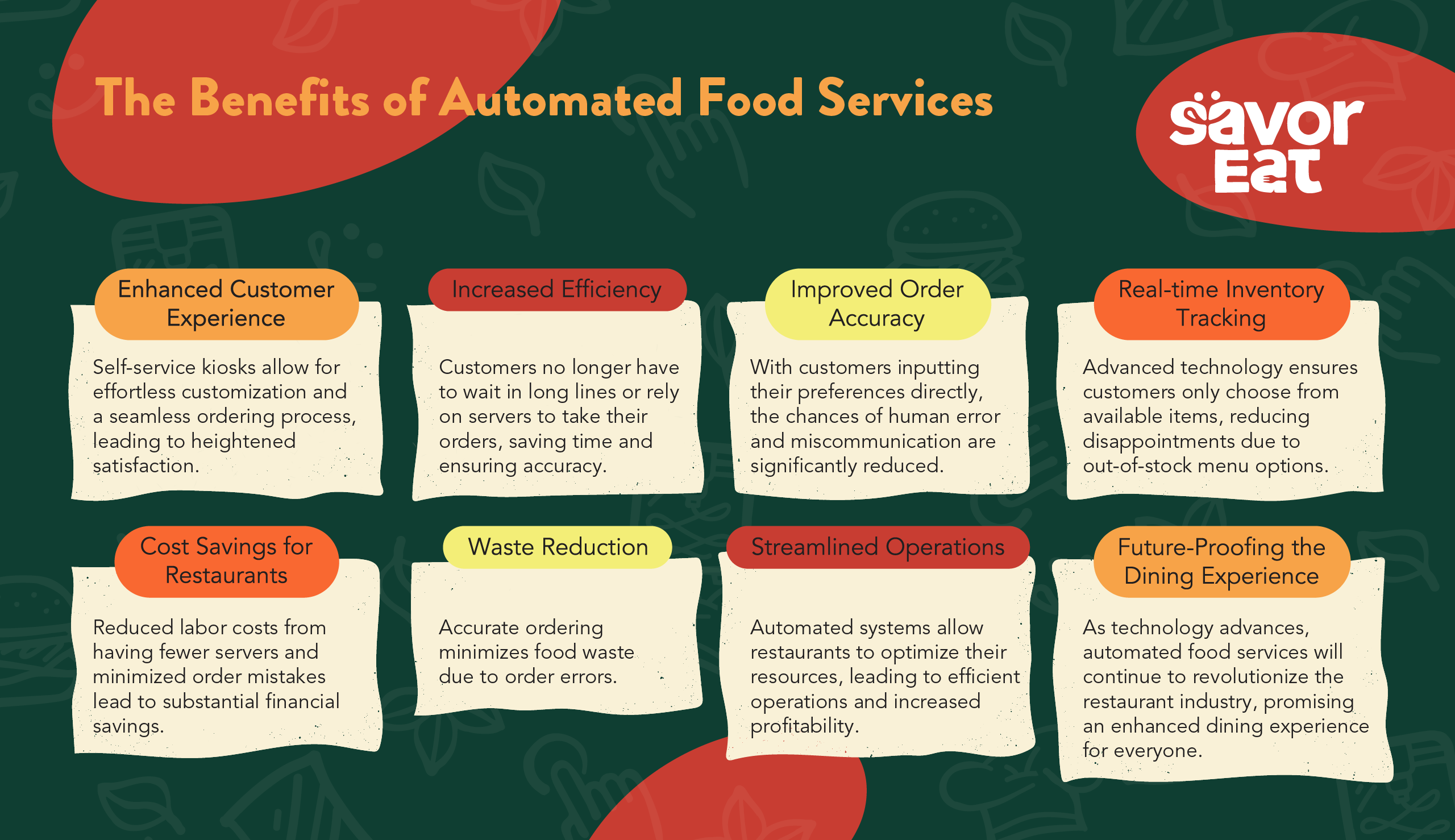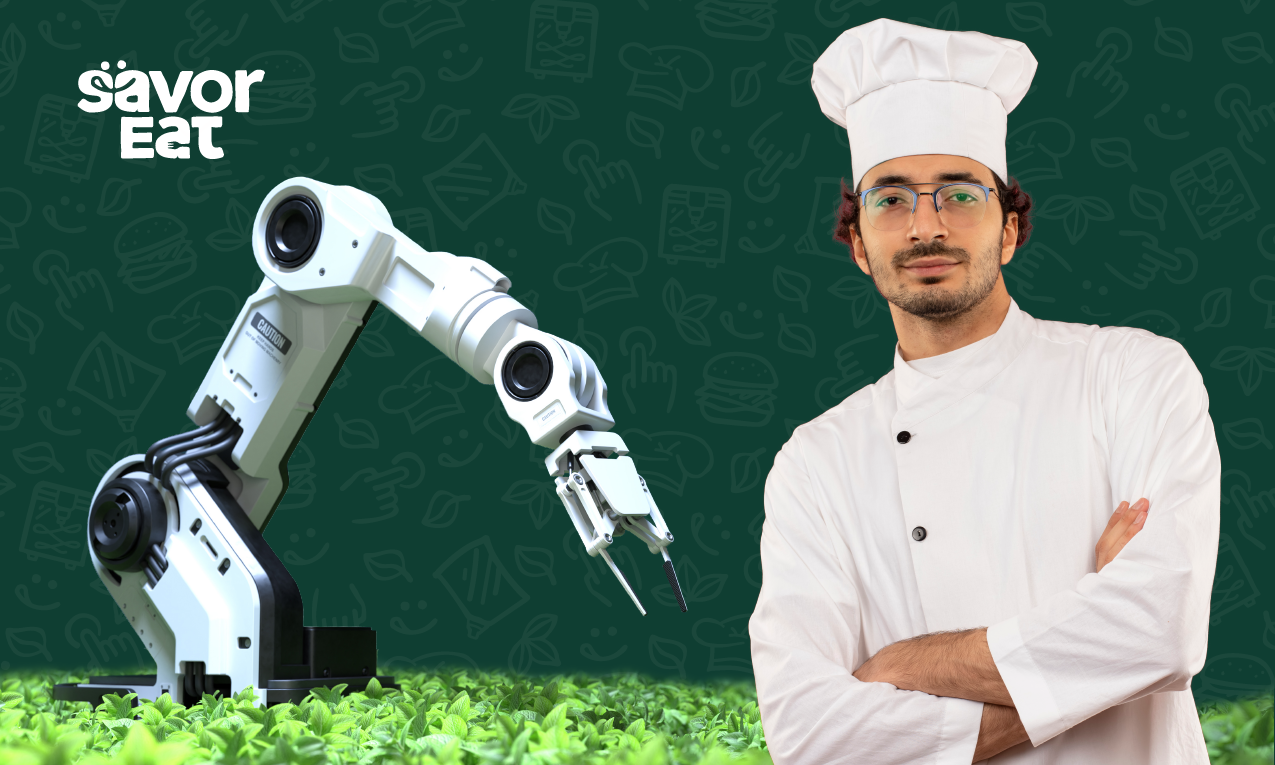Are you prepared to venture into the future of dining? Welcome to the fascinating realm of automated food services where robots are catalyzing a transformation in the restaurant business. This article will guide you through the profound impact of automation systems in reshaping our dining experiences, from the use of food processing equipment to the deployment of robotic kitchens.
In the first section, we’ll delve into the burgeoning trend of automated food services that started taking shape around 2021 and has been gaining momentum into 2022 and 2023. You’ll learn how restaurants may use automation to streamline tasks, from food preparation to delivery, enhancing efficiency and customer satisfaction along the way. Envision a future where robots work alongside human staff, playing a pivotal role in the evolution of the food sector.
Next, we’ll explore the innovative technology powering this dining revolution. From franchise operations like McDonald’s deploying self-service kiosks for customizable dining experiences to Chipotle using analytics to track special requests, automation is becoming more commonplace. You’ll discover game-changing robotic kitchen systems like those developed by Miso Robotics, including ‘Flippy,’ a robot designed to flip burger patties, apply condiments, and ensure consistent food quality.
The benefits of automation in the restaurant industry extend beyond efficiency. Automation can help reduce food waste, lower labor expenses, and maintain a small footprint – all of which are increasingly crucial in today’s food business landscape. Whether it’s a fully automated pizza vending machine from Wilkinson Baking Company or bots deployed by fast-food chains to deliver food, the ways many restaurants are using automation to improve operations are as diverse as they are revolutionary.
We’ll also discuss the cost of technology deployment and how automation can reduce costs in other areas like material handling and supply chain management. Plus, we’ll touch on the rise of contactless and online ordering systems, driven by JavaScript and similar technologies, that keep customers satisfied while minimizing the need for human contact.
Fasten your seatbelts and prepare to be amazed as we journey through the future of dining. From White Castle’s deployment of Flippy in locations across the United States to the scaling of automated systems in the fast-casual sector, the dawn of the automated dining revolution is here. If you’re intrigued by how automation and robots could fit your business needs, don’t hesitate to contact us.
Let’s embark on this enlightening journey together, exploring the intersection of technology and hospitality, where minimal labor meets maximum efficiency. The future of dining awaits!
The Rise of Automated Food Services
Robots are revolutionizing the restaurant industry by automating various tasks, such as food preparation, cooking, and even customer interaction. This rise of automated food services has both positive and negative implications.
On one hand, it leads to job displacement as robots replace human workers in performing repetitive tasks. This can have a significant impact on the workforce, especially for low-skilled workers who may struggle to find alternative employment opportunities. However, on the other hand, consumer preferences for faster service and increased efficiency are driving the adoption of automated food services. These robots can work tirelessly and consistently, ensuring that orders are prepared and delivered quickly and accurately.
In addition to addressing consumer preferences, the use of robots in the restaurant industry also offers cost efficiency benefits. While initial investments in robotics technology may be expensive, the long-term savings can be significant. Robots don’t require wages, benefits, or breaks, making them a cost-effective solution for businesses. Moreover, robots can be programmed to optimize ingredient usage, reducing waste and ultimately saving money for restaurant owners. This cost efficiency allows for potential price reductions, making dining out more affordable for consumers.
Technological advancements have played a crucial role in the rise of automated food services. Robots have become increasingly sophisticated and capable of performing complex tasks. From burger-flipping machines to automated baristas, these innovations are transforming the dining experience. With advancements in artificial intelligence and machine learning, robots are becoming more intuitive and adaptable, able to handle a variety of customer requests. This integration of technology in the restaurant industry is just the beginning, as we continue to witness the emergence of innovative solutions that enhance efficiency and convenience.
As we dive into the next section about innovative technology in the dining industry, it’s clear that the rise of automated food services has set the stage for a new era of dining. With job displacement, consumer preferences, cost efficiency, technological advancements, and the impact on the workforce all at play, the restaurant industry is undergoing a significant transformation. Innovative technology is paving the way for a more streamlined and efficient dining experience, where robots and humans work hand in hand to create a seamless and enjoyable experience for all.
Innovative Technology in the Dining Industry
Imagine walking into a restaurant and being greeted by a friendly machine that takes your order and guides you to your table. This is the reality of innovative technology in the dining industry.
With the advancement of AI-driven menus, you can now browse through a digital menu that’s personalized to your preferences and dietary restrictions. These menus are designed to analyze your previous orders and provide recommendations based on your taste. It’s like having a personal food consultant right at your fingertips.
But the innovation doesn’t stop there. Robotic waitstaff are becoming more common in restaurants, providing efficient and accurate service. These robots are programmed to take your order, serve your food, and even engage in small talk. They never get tired, never make mistakes, and are always friendly. It’s an experience that combines the convenience of automation with the warmth of human interaction.
In addition to AI-driven menus and robotic waitstaff, the dining industry is also embracing smart food delivery and virtual dining experiences. Smart food delivery services use GPS and AI technology to ensure that your food arrives at your door fresh and hot. Virtual dining experiences allow you to explore different cuisines and cultures from the comfort of your own home. Through virtual reality and augmented reality, you can virtually sit in a restaurant across the world and enjoy a meal, all without leaving your living room.
These technological advancements have even reached the beverage industry. Automated beverage dispensers are now available in some restaurants, allowing customers to customize their drinks with just a few simple taps on a touchscreen. Whether you want a soda, a cocktail, or a specialty coffee, these machines can make it for you in no time.
With all these exciting innovations, it’s clear that the future of dining is becoming increasingly automated and technology-driven. But what about the actual preparation of the food? That’s where robot chefs come in, and they’re a game-changer in food preparation.
Robot Chefs: A Game-Changer in Food Preparation
Get ready to experience a culinary revolution like never before with the introduction of robot chefs. These innovative culinary robots are completely transforming the way meals are prepared in restaurants.
With the rise of food automation and kitchen automation, robot chefs are becoming the game-changer in food preparation. Robot chefs are equipped with advanced technology and programming that allows them to perform various tasks in the kitchen. They can handle everything from chopping vegetables to cooking meals with precision and efficiency. They are designed to follow recipes and execute them flawlessly, ensuring consistent and high-quality dishes every time.
With robotic cooking, chefs can focus on other aspects of food preparation, such as creativity and presentation, while the robots take care of the repetitive and time-consuming tasks.
The introduction of robot chefs in the food industry is not only streamlining the cooking process but also improving food safety and hygiene. These robots are programmed to maintain strict cleanliness standards, reducing the risk of cross-contamination and foodborne illnesses. They can also work in high-temperature environments without any risk to their safety, making them suitable for cooking tasks that may be hazardous for humans.
With robot chefs, restaurants can enhance their efficiency, productivity, and overall dining experience.
As we transition to the subsequent section about self-service kiosks and customizing your dining experience, it’s important to note that the integration of robot chefs is just one aspect of the technological advancements in the dining industry. Self-service kiosks are another innovation that allows customers to have complete control over their orders and customize their meals according to their preferences.
Self-Service Kiosks: Customizing Your Dining Experience
Prepare yourself for a dining experience like no other as you step into a world where you have the power to personalize and create your perfect meal using self-service kiosks. With interactive menus at your fingertips, you can easily navigate through a wide range of options and customize your order to your exact preferences.
From selecting the type of bread for your sandwich to choosing the toppings and sauces, the self-service kiosks allow you to tailor your meal to suit your taste buds. Gone are the days of settling for a generic menu item; now, you have the freedom to create a culinary masterpiece that truly reflects your unique cravings.
Not only do self-service kiosks offer personalized orders, but they also provide a seamless and efficient ordering process. No longer will you have to wait in long lines or deal with miscommunication at the counter. With just a few taps on the touchscreen, your order is placed and sent directly to the kitchen.
This eliminates the potential for errors in taking down orders and ensures that your meal is prepared exactly as you requested. The digital payment system integrated into the kiosks further enhances the efficiency, allowing you to pay for your meal with ease and convenience. Say goodbye to fumbling for cash or waiting for the server to bring you the check; the self-service kiosks streamline the entire dining experience.
By empowering customers to personalize their orders and streamlining the ordering process, self-service kiosks ultimately aim to enhance customer satisfaction. With the ability to create a meal that suits your individual preferences, you’re more likely to leave the restaurant feeling satisfied and content.
Additionally, the efficiency of the ordering process means that your wait time is significantly reduced, allowing you to enjoy your meal without unnecessary delays. As a result, both the quality of the food and the overall dining experience are greatly improved.
Transitioning into the subsequent section about the benefits of automated food services, you’ll discover how these innovations not only benefit the customers but also the restaurant industry as a whole.

The Benefits of Automated Food Services
With self-service kiosks revolutionizing the restaurant industry, customers can now effortlessly customize their dining experience and enjoy a seamless ordering process, resulting in heightened satisfaction for both customers and restaurants alike.
These automated food services offer increased efficiency by eliminating the need for customers to wait in long lines or for servers to take their orders. With just a few taps on the screen, customers can browse the menu, choose their desired items, and make any necessary modifications. This not only saves time but also ensures that orders are placed accurately and without any miscommunication.
Moreover, automated food services improve accuracy in the ordering process. By allowing customers to input their own preferences and modifications, the chances of human error are significantly reduced. This means that customers can have confidence that their orders will be prepared exactly as they want them.
In addition, the kiosks are equipped with advanced technology that can track inventory in real-time, ensuring that customers are only able to select items that are available. This further minimizes the risk of disappointment due to unavailable menu items or ingredients.
Another major benefit of automated food services is the cost savings they offer to restaurants. With self-service kiosks, establishments can reduce labor costs by having fewer servers taking orders and processing payments. Additionally, these systems help prevent order mistakes, which can lead to wasted food and financial losses. By streamlining operations and reducing the margin for error, restaurants can operate more efficiently and optimize their resources, ultimately leading to cost savings and increased profitability.
Overall, the integration of automated food services in the restaurant industry enhances the customer experience and streamlines operations. Customers can enjoy a hassle-free ordering process, customizing their meals to their liking and receiving accurate and timely service. Meanwhile, restaurants benefit from increased efficiency, improved accuracy, cost savings, and streamlined operations. As technology continues to advance, it’s clear that automated food services are here to stay, transforming the way we dine and ensuring a more satisfying experience for all.
Conclusion
In conclusion, the future of dining is undoubtedly being shaped by the rise of automated food services. As you’ve explored in this article, robots are revolutionizing every aspect of the dining experience, from food preparation to customer service. These cutting-edge technologies are not only increasing efficiency and improving customer satisfaction but also creating a whole new level of dining experiences.
Imagine a world where robot chefs, with their precision and speed, can cook up a storm in the kitchen, serving delicious meals with impeccable presentation. Picture yourself customizing your dining experience through self-service kiosks, where you can personalize your order to perfection. With automated food services, the possibilities are endless.
So, whether it’s the tantalizing aroma of freshly prepared dishes or the convenience of ordering and receiving your meal with just a few taps, the future of dining has never been more exciting. As the saying goes, “The proof of the pudding is in the eating.”And with these innovative robots taking center stage in the restaurant industry, the proof is indeed in the unforgettable dining experiences they create.
Sit back, relax, and get ready to be wowed by the incredible world of automated food services. The future of dining is here, and it’s served with a side of technological marvels.





